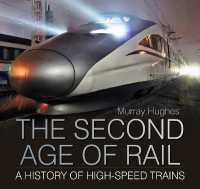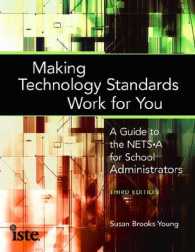Full Description
ALERTcourse syllabus to ensure that you select the correct ISBN. Several versions of Pearson's MyLab & Mastering products exist for each title, including customized versions for individual schools, and registrations are not transferable. In addition, you may need a CourseID, provided by your instructor, to register for and use Pearson's MyLab & Mastering products.PackagesAccess codes for Pearson's MyLab & Mastering products may not be included when purchasing or renting from companies other than Pearson; check with the seller before completing your purchase.Used or rental booksIf you rent or purchase a used book with an access code, the access code may have been redeemed previously and you may have to purchase a new access code.Access codesAccess codes that are purchased from sellers other than Pearson carry a higher risk of being either the wrong ISBN or a previously redeemed code. Check with the seller prior to purchase.--This access code card gives you access to all of MySearchLab's tools and resources, including a complete eText of your book. You can also buy immediate access to MySearchLab with Pearson eText online with a credit card at www.mysearchlab.com.Examines the development and impact of capitalist cultureFrom its roots more than 500 years ago to the present day, capitalism expanded from Western Europe to the United States and then to much of the rest of the world. This expansion has not gone uncontested; resistance has been both direct and indirect, including political, religious, and social protest, and even revolution. How and why capitalist culture developed and the reasons why some groups resisted and continue to resist its development are among the issues explored in Global Problems and the Culture of Capitalism, 6/e.MySearchLab is a part of the Robbins program. Research and writing tools help students master basic writing skills. With MySearchLab, students can access various academic journals, census data, and Associated Press news feeds, broadening their views on important issues.
Contents
In this section:1) Brief Table of Content2) Full Table of ContentsPART 1 - THE CONSUMER, THE LABORER, THE CAPITALIST, AND THE NATION-STATE IN Chapter 1: Constructing the Consumer Chapter 2: The Laborer in the Culture of Capitalism Chapter 3: The Rise and Fall of the Merchant, Industrialist, and Financier Chapter 4: The Nation-State in the Culture of Capitalism Chapter 5: Population Growth, Migration, and Urbanization Chapter 6: Hunger, Poverty, and Economic Development Chapter 7: Environment and Consumption Chapter 8: Health and Disease Chapter 9: Indigenous Groups and Ethnic Conflict PART 3 - RESISTANCE AND REBELLION Chapter 10: Peasant Protest, Rebellion, and Resistance Chapter 11: Anti-Systemic Protest Chapter 12: Religion and Anti-Systemic Protest Chapter 13: Solving Global Problems: Some Solutions and Courses of Action PART 1 - THE CONSUMER, THE LABORER, THE CAPITALIST, AND THE NATION-STATE IN A Primer on Money: The Philosopher's Stone Chapter 1: Constructing the Consumer Remaking Consumption Kinderculture in America: The Child as Consumer Exporting the Consumer Chapter 2: The Laborer in the Culture of Capitalism A Primer on the Elements of Capitalism The Construction and Anatomy of the Working Class Chapter 3: The Rise and Fall of the Merchant, Industrialist, and Financier The Era of the Global Trader The Era of the Industrialist The Era of the Corporation, the Multilateral Institution, and the Capital Speculator The "Second Great Contraction" Chapter 4: The Nation-State in the Culture of Capitalism The Origin and History of the State Constructing the Nation-State Spin, Free Trade, and the Role of Energy in the Global Economy A Primer on Market Externalities: Polanyi's Paradox Chapter 5: Population Growth, Migration, and Urbanization The Malthusians Versus the Revisionists Demographic Transition Theory Population Growth in the Periphery Issues of ImmigrationChapter 6: Hunger, Poverty, and Economic Development The Evolution of Food Production: From the Neolithic to the NeocaloricThe Politics of Hunger Solutions and Adaptations to Poverty and Hunger Chapter 7: Environment and Consumption The Case of Sugar The Story of Beef Creating a Taste for BeefThe Impact of Production On The Environment: The Effects of Climate ChangeChapter 8: Health and Disease A Primer on How to Die from an Infectious Disease The Relationship between Culture and Disease AIDS and the Culture of Capitalism Chapter 9: Indigenous Groups and Ethnic Conflict The Fate of Indigenous Peoples The Guarani: The Economics of Ethnocide Disadvantaged Majorities and Their Revenge PART 3 - RESISTANCE AND REBELLION A Primer on Terrorism Chapter 10: Peasant Protest, Rebellion, and Resistance Malaysia and the Weapons of the Weak Kikuyu and the Mau Mau Rebellion The Rebellion in Chiapas Chapter 11: Anti-Systemic Protest Protest as Anti-Systemic: The Two World Revolutions The Protests of Labor: Coal Miners in Nineteenth-Century Pennsylvania Global Feminist Resistance Direct Action and Occupy Wall StreetChapter 12: Religion and Anti-Systemic Protest Indigenous Religious Movements as Anti-Systemic Protest The Global Challenge of Anti-Systemic Religious Protest "Terror in the Mind of God" Chapter 13: Solving Global Problems: Some Solutions and Courses of Action The Central Dilemma of GrowthThings We Could Do








